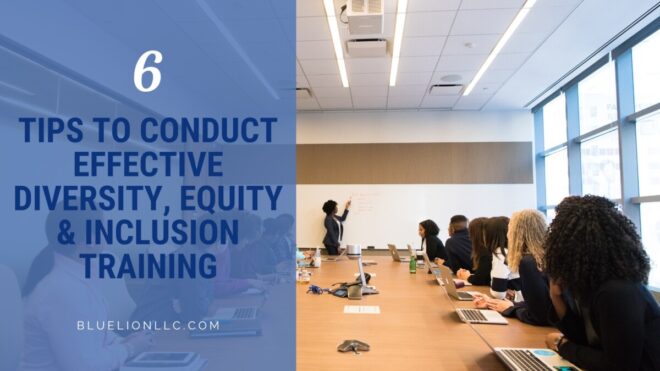
Although diversity, equity, and inclusion (DEI) is becoming a much higher priority for many organizations, all kinds of inadequate DEI training remain. While missing the mark in this sensitive area can subject your company to risk, it’s also easy to avoid making mistakes by following some simple rules.
First, your entire team—from C-level leaders to the newest entry-level hires—must understand what DEI is and why it matters. It’s also vital to get buy-in from your leadership, who must set a positive example for everyone else.
Below, we explore:
- The definition of diversity, equity, and inclusion
- How it benefits your employees and overall business
- Six tips for developing effective DEI training
What is Diversity, Equity, and Inclusion?
Diversity recognizes how individuals of a specific group differ based on their identities and life experiences. Our identities may vary based on:
- Race
- Gender
- Age
- Sexual orientation
- Nationality
- Religious/spiritual beliefs
- Disabilities
- Socioeconomic status
Diversity training creates awareness of our differences and equips us to overcome our unconscious biases.
Equity acknowledges that our identities impact our opportunities, and some of us have more access than others. It defines how we address diversity and the steps to provide more opportunities to marginalized groups who have historically faced more barriers. Note that equity differs from equality, which focuses on giving equal resources and opportunities to all but doesn’t necessarily close the gaps for those with significantly less.
Inclusion, also known as belonging, refers to the steps we take to make everyone feel welcome, supported, and respected. This is about creating a safe, compassionate work environment for all individuals and groups regardless of their identities and circumstances.
DEI practices apply to employees, customers, and stakeholders. These initiatives include:
- Policies (e.g., anti-harassment and discrimination and family leave policies)
- Procedures (e.g., inclusive hiring practices)
- Programs and training
Why is DEI Training Important?
DEI training and initiatives create a safe, respectful, and welcoming culture for employees, customers, and all stakeholders. It also fosters empathy for one another and our different backgrounds and identities.
By addressing crucial topics like anti-harassment and discrimination, unconscious bias, microaggressions, and implicit biases, DEI training teaches us how these issues can affect our workplace. It also gives us the tools we need to overcome these biases and become allies for one another.
Not to mention, DEI training is a wise investment because it:
- Results in a more diverse workforce, which brings more ideas, innovation, and perspectives to the table
- Improves employee retention, morale, and experience
- Leads to a happier, more productive workforce—which helps your company’s bottom line
6 Tips to Ensure Your DEI Training Makes an Impact
1. One-size-fits-all training doesn’t exist.
The most effective DEI training programs are customized to meet your organization’s unique needs. Whether your internal HR team handles it or you outsource this function to an HR consulting firm, they should adjust your training based on the needs of your:
- Organization
- Audience
- Budget
An essential piece of this is matching the tone, style, and content of your training to match your audience. For example, if you’re training employees who are newer on their jobs or have been working in their positions for less than six months, you might want to use more humor and fun stories than if you were conducting a training for more senior-level staff.
Each workshop or session should focus on a specific topic, such as harassment training, cultural diversity, generational diversity, migroaggressions, and inclusive hiring practices. Addressing issues relevant to your team will resonate much better with them than holding a broad DEI training that attempts to cover too many topics in a short time.
2. The goals and size of your company matter.
When determining what kind of DEI training will be most relevant and impactful to your team, your leadership and HR team should ask:
- What is the purpose of our DEI training?
- How much time do we have to devote to it?
- What level of diversity does the company have?
- Do we have any DEI-related policies in place? If so, which ones?
- What behaviors do we want our managers and employees to engage in regularly?
- What behaviors are causing problems at work that need to be changed?
- What would make us more diverse as an organization (e.g., gender diversity)? How can we achieve this goal efficiently while also maintaining quality control standards?
Before you develop DEI training, it is essential to know what behaviors are causing problems and how those behaviors negatively impact individuals. Identify the behaviors you want to change through your DEI training by including examples of the conduct in question and explaining why those behaviors are problematic. The more specific you can be about what needs improvement, the better off everyone will be when the training process is complete.
When setting goals for your DEI efforts, ensure they include measurable benchmarks so everyone knows exactly what needs to happen before they can work toward doing it. If possible, try creating a timeline with milestones along the way so employees have something tangible to track their progress against while they’re learning new ways of working together (this could also help ensure internal accountability).
3. Address the elephant in the room right up front.
It’s important to address any concerns about DEI training before you begin. You or your HR team can ask for feedback on what participants hope to get from the session and how they’d like it structured.
Suppose you’re unclear about your intentions or what outcomes you hope to achieve with this training program. In that case, people may feel uncomfortable or confused during all stages of your presentation—and it could undermine the effectiveness of everything else that follows!
4. Make sure it’s interactive and engaging.
The best way to ensure your DEI training is effective is by making it interactive. This means that participants should be actively involved in the training and feel engaged and interested in the material. They’ll get more from the lesson and be better equipped to carry out their work duties with a strong understanding of diversity, equity, and inclusion.
To encourage active participation, the trainer should prompt questions from participants throughout the session. This can be done through polling before the training, where you can ask questions anonymously (if preferred).
When addressing behavior, it’s best not to lecture, read aloud or hand out documents. Instead, engage participants in active learning by doing. DEI training tools can include the following:
- Games, activities, and exercises that require your audience to engage with one another are ideal for making connections between concepts and ideas and promoting discussion.
- Group discussions can be led by the trainer or participants based on their own experiences.
- Role-plays allow people to practice real-life scenarios using their own names and circumstances instead of those scripted beforehand by the trainer.
- Case studies allow participants to explore situations similar to those they may face at work while simulating real-life scenarios—all in a safe training environment!
- Simulation games allow learners to experiment with different behaviors before putting them into practice back on the job; this allows them time for reflection after each exercise, so they’re better prepared when interacting with others later on.
- Visual aids such as posters or flipcharts can also help keep participants engaged during training sessions; use these tools wisely, though, because too many visual aids could distract from the actual lesson.
6. Find a DEI trainer with practical experience.
Your DEI trainer should be a subject matter expert and an experienced facilitator, educator, or trainer. This includes experience:
- In the field: DEI training comes from various perspectives, including but not limited to race, gender, and sexual orientation. Trainers should have personal experience in one or more of these areas.
- In the workplace: DEI training requires understanding corporate culture and structure. Trainers must also understand how to create an environment conducive to learning while maintaining safety standards for all participants.
- With training: Trainers should be skilled at training others on recognizing unconscious bias and how it affects decision-making processes within an organization or institution.
- Handling resistance: An experienced trainer knows how to recognize negative feedback and work with those who don’t want to participate or attend another session. They should also know how to redirect negative responses into a productive discussion and get everyone back onto common ground.
- With marginalized populations: DEI trainers should understand how to work with vulnerable populations, including people with disabilities, people of color, women, LGBTQIA+ individuals, and others who have faced barriers in the workplace.
For example, a trainer who doesn’t understand how their language may be exclusionary towards women will likely not provide impactful DEI training for a group that includes some women. Similarly, an individual who does not identify as LGBTQIA+ will probably be less equipped to deliver effective DEI training for this population due to a lack of knowledge about this community’s unique issues.
7. Send a pre-training and post-training survey—then follow up!
Pre-training surveys can help you gauge whether your participants have a knowledge of diversity, equity, and inclusion issues or are not as familiar with these concepts. Thus, they’re a great way to get an idea of what your participants hope to learn during the training.
After each DEI workshop, follow up with participants who write something negative about their experience to find out what can be done better next time a similar training is offered. It should be a fluid area, with your HR department or outsourced HR firm constantly adjusting to meet the needs of your entire company and help you build the most inclusive environment possible.
DEI Training Takeaways
DEI training is an essential part of the workday in today’s workplace. Organizations that don’t provide this training are putting themselves at risk for lawsuits, costing your company a lot more than DEI training ever will. So it’s worth taking the time to do things right from the beginning!
Risk and cost aside, DEI training is also the right thing to do. You’ll show current and prospective employees that you care about their overall well-being and accept them for who they are. In the end, this approach will help your business grow stronger naturally.
If you have questions about diversity, equity, and inclusion or are ready to enlist the help of expert DEI trainers, contact us today at 603-818-4131 or info@bluelionllc.com to learn how BlueLion can help!
The information on this website, including its newsletters, is not, nor is it intended to be legal advice. You should contact an attorney or HR specialist for advice on your individual situation.


